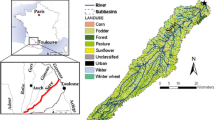Abstract
Loss of two pesticides with different mobility characteristics, bentazone (Koc ∼ 34) and propiconazole (Koc ∼ 1800), were studied at three agricultural fields (Askim, Bjørnebekk and Syverud) in SE Norway. A conservative tracer (Br) was used to follow the flow of water. The loss of pesticides varied among the fields, depending on hydrological characteristics and soil properties. The loss of pesticides was higher from two artificially levelled silty clay loam soils with poor aggregate stability (Askim and Bjørnebekk) compared to a loam/silt loam soil with increased content of organic carbon and better aggregate stability (Syverud). The total accumulated loss was <0.5% from all fields. The highest pesticide concentrations were measured at the first runoff episode after application for both the mobile (bentazone) and less mobile pesticide (propiconazole) in the surface runoff. In the drainage water, the peak for the less mobile pesticide coincided with the Br tracer, while the peak for mobile pesticide appeared earlier than the Br tracer. Rapid movement of water, particles and pesticides through soils indicate flow through macropores. Larger proportions (in percent of total applied) of both the mobile and the strongly sorbed pesticides were lost through the drainage as compared to the loss through surface runoff at Askim. Here, it is suggested that macropore flow contribute to the increased loss of pesticides through the drainage. At Syverud, high infiltration capacity reduces the amount of water available for surface runoff, and somewhat higher loss of the mobile pesticide was registered in the drainage compared to the surface runoff. For the strongly sorbed pesticide, however, propiconazole was neither detected in surface nor in drainage water at Syverud. Generally, there was a higher percentage loss of the mobile compared to the strongly sorbed pesticide in both surface and drainage water, which is in agreement with the pesticides mobility characteristics in soil. An exception was, however, the erodible soil Bjørnebekk, where a higher fraction of propiconazole was lost in the surface runoff compared to bentazone. Large amounts of sediment transport from the Bjørnebekk field probably contributed to enhanced transport of the strongly sorbed pesticide.
Similar content being viewed by others
References cited
de Jonge H, Jacobsen OH, de Jonge LW, Moldrup P. 1998 Particle-facilitated transport of prochloraz in undisturbed sandy loam soil columns. J Environ Qual 27, 1495–1503.
Enfield CG, Bengtsson G. 1988 Macromolecular transport of hydrophobic contaminants in aqueous environments. Ground Water 26, 64–70.
Flury M. 1996 Experimental evidence of transport of pesticides through field soils-a review. J Environ Qual 25, 25–45.
Gentry LE, David MB, Smith-Starks KM, Kovacic DA. 2000 Nitrogen fertilizer and herbicide transport from tile drained fields. J Environ Qual 29, 232–240.
Källqvist T, Romstad R. 1994 Effects of agricultural pesticides on planctonic algae and cyanobacteria–examples of interspecies sensitivity variations. Norw J Agric Sci 13, 117–131.
Kladivko EJ, Grochulska J, Turco RF, van Scoyoc GE, Eigel J. 1999 Pesticide and nitrate transport into subsurface tile drains of different spacing. J Environ Qual 28, 997–1004.
Leonard RA. 1990 Movement of pesticides into surface waters. In Cheng HH, ed. Pesticides in the Soil Environment SSSA Book Ser. 2 SSSA. WIP: Madison, pp. 303–349.
Liess M, Schulz R, Liess MHD, Rother B, Kreuzig R. 1999 Determination of insecticide contamination in agricultural headwater streams. Water Res 33, 239–247.
Lundekvam H, Skøien S. 1998 Soil erosion in Norway. An overview of measurements from soil loss plots. Soil Use Manage 14, 84–89.
Neumann M, Schulz R, Schäfer K, Müller W, Mannheller W, Liess M. 2002 The significance of entry routes as point and non-point sources of pesticides in small streams. Water Res 36, 835–842.
Riise G, Krogstad T, Eklo OM, Lode O, Pettersen MN, Salbu B. 2002 The influence of composted material on the leaching of pesticides with different water solubility. Planteforsk.
Thorstensen CW, Lode O. 2001 Laboratory degradation studies of bentazone, dichlorprop, MCPA, and Propiconazole in Norwegian Soils. J Environ Qual 30, 947–953.
Wu Q, Riise G, Kretzschmar R. 2003 Size distribution of organic matter and associated propiconazole in agricultural runoff material. J Environ Qual 32, 2200–2206.
Author information
Authors and Affiliations
Rights and permissions
About this article
Cite this article
Riise, G., Lundekvam, H., Wu, Q. et al. Loss of Pesticides from Agricultural Fields in SE Norway – Runoff Through Surface and Drainage Water. Environmental Geochemistry and Health 26, 269–276 (2004). https://doi.org/10.1023/B:EGAH.0000039590.84335.d6
Issue Date:
DOI: https://doi.org/10.1023/B:EGAH.0000039590.84335.d6




